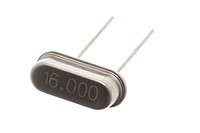
Photo from wikipedia
Abstract We utilized electrochemical quartz crystal microbalance to understand electrochemical passivation of the zinc electrode in alkaline media and subsequent oxide growth and stripping. The formation of native zinc oxide… Click to show full abstract
Abstract We utilized electrochemical quartz crystal microbalance to understand electrochemical passivation of the zinc electrode in alkaline media and subsequent oxide growth and stripping. The formation of native zinc oxide on a near pristine Zn surface upon contact with 1 M KOH electrolyte was observed. The surface was seen to roughen with time. During Zn dissolution, the measured mass-charge ratio corresponded to the removal of ZnO and not merely Zn. The mechanism of passivation was determined to be caused by electrochemical etching to form pores. The etching leads to a build-up of solid ZnO and Zn(OH)2 due to electrochemical reactions on the surfaces of the pores. These reactions functionally close the pores off from the bulk. The cycle of Zn deposition and dissolution develops a porous network, which may be the origin of mossy Zn deposits that plague reversible Zn metal batteries.
Journal Title: Journal of Power Sources
Year Published: 2019
Link to full text (if available)
Share on Social Media: Sign Up to like & get
recommendations!